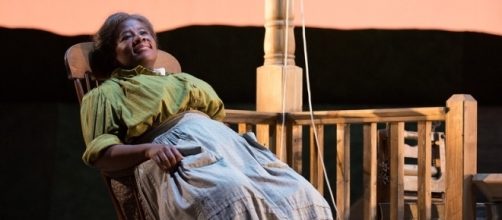“Oklahoma!”, by Richard Rodgers and Oscar Hammerstein II, is Glimmerglass Festival’s selection from classic American musical theater in an otherwise strictly operatic season. Everything Music and Theatre reviews for you the Friday, July 14, performance of the 1943 Broadway hit, in Cooperstown, N.Y. Maestro James Lowe leads the 45-member Glimmerglass Opera Orchestra in a rousing, idiomatic reading of the score, accent on Southwestern rhythms and tunes. A solid lineup of soloists from both operatic and musical theater training and backgrounds and dancers galore, including ballet dancers, guarantees loads of fun for everyone.
Home, Sweet Home
Artistic and General Director Francesca Zambello focuses the four works in this Festival season on the concept of home and how it defines us. Set in 1903’s Oklahoma Territory—statehood came in 1907—“home” for Laurey, her Aunt Eller, Curly and all the rest was property that white settlers claimed starting in 1889. To lay claim, they first had to dispossess various Native American nations in what was America’s Indian Territory. A massive government-sanctioned removal to federally owned lands allowed good ole white folks to live together, though not always peaceably, and segregated the Native American population. It was tantamount to their saying: “Yeah, we know you’ve been here for millennia and everything, but it’s God’s will for us to inhabit these parts, so would you mind?” None of this seems to worry the jolly folks in “Oklahoma!”
The big issue
No, in the Oklahoma of “Oklahoma!”, everyone’s chief concern is: Whoever will escort Laurey Williams to the dance?
Will it be the cheerful, handsome, though somehow proudly bow-legged Curly, or will it be ominous Jud Fry, the disturbing, creepy loner? Of course, it’s not hard to guess which lad has everyone rooting for him. And yet, without giving anything away, Oscar Hammerstein skillfully cultivates this meager sliver of a shred of dramatic conflict, which steadily intensifies to foster a sense of impending doom.
Romantic leads
Vanessa Becerra, Jarrett Ott and Michael Hewitt as Laurey Williams, Curly McClain and Jud Fry—obsessed with Laurey—form a worrisome love triangle. Jud’s foreboding aria, “Lonely Room,” often cut, is left intact, fortunate for us who get the benefit of Mr. Hewitt’s burnished baritone in an all-out dramatic vocal display.
The romantic leads, though excellent in solo numbers, catalyze each other and do even better in their duets, never more so than “People Will Say We’re in Love.” The three have successfully made the “crossover” from opera to American musical theater with none of the affected pronunciation; indeed, Southwestern twang and nasalities are not beneath them. Mr. Ott’s warm baritone gratifies in all ranges, and Ms. Becerra’s bright soprano pleasurably expands when approaching the higher reaches.
Comic relief
Another, more-frivolous romantic triangle forms among Emma Roos as Ado Annie Carnes, who “cain’t say no” to any feller that wants to kiss her, Michael Roach as bronco-busting Will Parker and Dylan Morrongiello as Ali Hakim, the traveling salesman.
Ado Annie’s dilemma about which man to marry, either the one who really wants to marry her or the other one, who really doesn’t, provides comic relief for those moments of steadily mounting dramatic tension. The three have pleasant voices, though Mr. Morrongiello scarcely had the chance to display his, his role heavily cut. The sweet-voiced Michael Roach … what a dancer!
@Glimmerglass Opera Festival--Oklahoma! in the farmlands of NY State. Spirited production w/45 member orchestra and no amplification. pic.twitter.com/iumVTmLX09
— Molly Smith (@msmitharena) 10 July 2017
Moral compass
William Burden, Glimmerglass Festival’s 2017 season Artist-in-Residence, as Sheriff Andrew Carnes, keeps Will and Ali focused on his daughter while urging ‘the farmer and the cowman to be friends.’ In a commendable case of racially blind casting, Judith Skinner appears as Aunt Eller Murphy, who keeps all the young folks on the right path.
She appears in back-to-back performances of “Porgy and Bess,” from Thursday night, in which she plays Maria. Her histrionically effective voice is put to use mainly in powerful spoken passages, which she clearly enunciates and projects without blasting.
Oklahoma! opens with a western yell @Glimmerglass Opera in NY State. Runs most of August.
— Molly Smith (@msmitharena) 10 July 2017
Imagine: 45 member orchestra--no amplification! pic.twitter.com/hG4qeXCtb9
Skillful direction
Maestro James Lowe leads orchestra, chorus and soloists, even the dancers, from the pit in brisk tempi, perhaps too brisk in the Act II opener, “The Farmer and the Cowman Should Be Friends.” Choreographer and Fight Choreography Supervisor Parker Esse keeps everyone moving, sometimes frenetically.
It’s amazing how much fighting goes on among so-called good Christians inheriting their ‘promised land.’ Mr. Esse keeps it real (enough), and the dream sequence ballet, danced by singers Olivia Barbieri and Ezekiel Edmonds, is exceptionally well-executed.
Oklahoma!’s look and feel
Director Molly Smith leads a particularly creative crew of designers and moves her singers and actors throughout the theater, even the aisles, fluidly. Sets Designer Eugene Lee has produced the bare minimum—though sufficient—suggestions of the Southwest in simple structures that can roll on- and offstage. Costume Designer Ilona Sommogyi clothes everyone colorfully. Kudos to Lighting Designer Robert Wierzel, whose “dawn” in the opening number, “Oh, What a Beautiful Mornin’” was fancifully realistic.
“Oklahoma!” by Richard Rodgers and Oscar Hammerstein II, till Aug. 22, 2017, at Glimmerglass Festival, Alice Busch Opera Theater, Cooperstown, N.Y.


